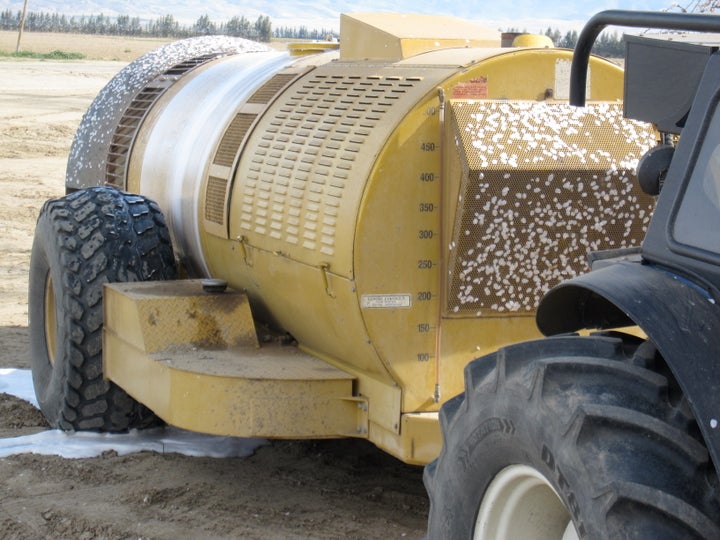
I have written extensively on farming and especially pesticides for two reasons.
I am convinced agriculture for millennia was civilization. But since the late nineteenth century farming was forced to industrialize supposedly to feed the world. Giant farms growing one crop rang the dinner bell for countless insect-pests. This triggered a chemical warfare at the farm.
Industrialization brought the violent metamorphosis of civilization to a factory. Pesticides became the pillars of this factory.
Second, my lengthy work for the US Environmental Protection Agency convinced me pesticides, like nuclear bombs, have to be abolished. Their warfare history and effects are simply intolerable.
A UK beekeeper friend, Graham White, brought to my attention the work of professor Dave Goulson at the University of Sussex. Goulson carried out a ‘Pesticide Audit’ of one single field of oilseed rape and one of winter wheat.
The pesticide audit covered one season, 2012-2013. It revealed that any honeybee, butterfly, bumblebee, ladybird, earthworm, feeding from oilseed rape field would be exposed to:
SIX insecticides,
THREE herbicides,
NINE fungicides
Plus insect hormone growth regulators.
The deleterious effects of this cocktail of poisons are deforming and killing wildlife, though scientists have yet to study the mixtures of so many poisons working together.
The oilseed rape field was not unusual. Most UK and American farmers are encouraged to use the same cocktail of sprays. In the UK over 8,000,000 hectares of arable crops every year follow this chemical recipe.
Professor Goulson says he found the evidence of his audit “astonishing.” I found it outrageous.
Professor Goulson looks at farming with the eyes of pollinators, honeybees and bumblebees. Indeed, he is UK’s preeminent bumblebee scientist.
Goulson focused on the oilseed rape because when it flowers it becomes a food store for honeybees.
He explains: “[Oilseed rape] is sown in late summer with a seed dressing containing the insecticide thiamethoxam. This is a systemic neonicotinoid, with exceedingly high toxicity to bees.
“We know it is taken up by the plant, and that detectable levels will be in the nectar and pollen gathered by bees in the following spring.
In November, despite the supposed protection of the neonicotinoid, the crop is sprayed with another insecticide, the charmingly named ‘Gandalf’.
“What harm could the wise old wizard possibly do? Gandalf contains beta-cyfluthrin, a pyrethroid. Pyrethroids are highly toxic to bees and other insects, but there should be no bees about in November so that is probably OK. The following May, when it is flowering, the crop is sprayed with another pyrethroid, alpha-cypermethrin.
“Less than three weeks later, the crop is blitzed with three more pyrethroids, all mixed together, a real belt-and-braces approach.
Why use one when three will do? The crop is still flowering at this point (it was a late year), and would be covered in foraging bumblebees and other pollinators. “In between, the crop is also treated with a barrage of herbicides, fungicides, molluscicides and fertilizers – 22 different chemicals in total. Most of these may have little toxicity to bees in themselves, but some, such as a group of fungicides (the DMI fungicides), are known to act synergistically with both neonicotinoids and pyrethroids, making the insecticides much more toxic to bees. On the final application date, when the crop is flowering, one of these fungicides (prothioconazole) is added to the tank mix with the three pyrethroids. Any bee feeding will be simultaneously exposed to the three pyrethroids, the thiamethoxam in the nectar and pollen, and a fungicide that makes these insecticides more toxic. “We don’t know what impact all of this really has on them. The safety tests only expose test insects to just one chemical at a time, usually for just 2 days, but in reality they are chronically exposed to multiple pesticides throughout their lives. The fact that we still have bees in farmland suggests that they must be pretty tough. More broadly, we don’t know what impacts all of this has on other pollinators, or wildlife in general. Industry would tell us that all is well. They would also tell us (and the farmers that they advise) that all of these applications are vitally important parts of crop production, and that without them food production would collapse. I have my doubts.
“Is this really how we want to see the countryside managed?
“Do we really want to eat food produced this way?
“Do we really think ANY insects, soil biota, birds or mammals can survive this chemical barrage, year after year after year?”
My answer is NO. Goulson is right. Pesticide mixtures are deadly to pollinators and other wildlife, especially when the same barrage of chemicals hits the crops year after year after year. Pesticides don’t belong in the countryside and the raising of food. You would not want to feed your children with this sprayed food.
The chemical industry, like the tobacco industry, is unlikely to come to its senses. It manipulates politics and science to maintain its poison empire. As long as it has the support of the rulers of the UK, America or other countries, pesticides and large industrialized farms will reign supreme; food and drinking water will be contaminated, and wildlife will be poisoned.
There are probably many scientists like Goulson who know why pesticides are killing wildlife and make rural England and rural America unfit for human habitation and food production. These scientists should talk to their colleagues, including doctors, and, together, should say enough is enough. Their letters should reach UN officials, prime ministers, presidents, newspaper editors and politicians.
Beekeepers need to rise up for saving their bees and the natural world. They have seen the decline or destruction of their livelihoods. They probably know the most about the terrible neonicotinoids and other chemicals poisoning bees and insects. Take that information and knowledge to the public square. Work with organic farmers, chefs, teachers, and environmentalists to stop the coming dark age of neurotoxins and silence.
